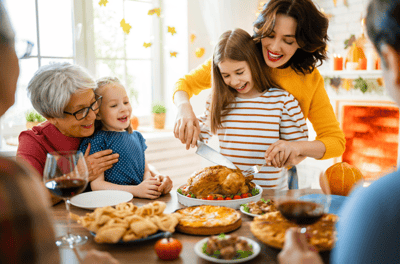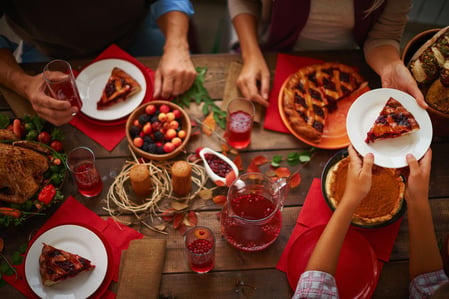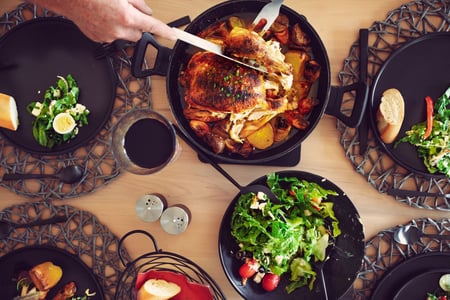Navigating Carb-Centered Holidays Like Thanksgiving
By Jewels Doskicz

Food-focused holidays like Thanksgiving can pose a challenge for people with diabetes and obesity. Here’s how one person with type 1 diabetes navigates the holiday.
Holiday eating can be tricky with diabetes (sweet potato casserole with marshmallows on top, I’m talking about you). To be fair, I’ve never heard anyone refer to Thanksgiving dinner as a “healthy meal,” so it’s not an overindulgent surprise. But while Thanksgiving may not be a holiday of deprivation, noshing beyond my fill has only ever given me eater’s remorse.
So, I’ve come to a certain conclusion: It’s moderation (and lots of vegetables) for the win.
In all seriousness though, I realize the way we eat can be very personal, regardless that we hold diabetes in common. Facing a spread of food that can trigger all sorts of responses and having a chronic disease that needs to be managed can have its own set of difficulties. Practicing self-kindness, while keeping time in range goals top of mind, can be tough on carb heavy holidays, so finding what works best for you is key.
Unless someone can see deeply into our souls, most people never know the mental gymnastics we go through around the holidays. People with diabetes are quiet warriors who belly-up to huge buffets of food year after year, with expected super-human powers of resistance in tow. It’s a true testament to finding balance – with a sprinkle of self-compassion.
Handle Thanksgiving like a boss
Overeating can steal my sparkle, so I try really hard to avoid a food coma on Thanksgiving – especially one that coincides with high glucose levels. So how do I find my happy-medium and not faceplant on the couch? I give most of the credit to non-starchy vegetables.
What’s the hype about vegetables? They’re often low-carb, nutritious choices that create fullness and help to keep my glucose in range. By starting off with veggies and having a belly full of greens, I’m less likely to overindulge (it’s vegetable science). If you don’t like veggies, it’s never too late to try something new. I swear I put salad on my daughter’s plate for two years before she would eat it – never give up on yourself.
My food choices are often driven by how I think they’ll make me feel, which varies with how active my day is. If I had to slap a label on myself, I’d say I’m an intuitive eater, not really identifying with foods as being “good” or “bad.” I know that eating a huge carb dump doesn’t feel the best for me, so I moderate with a balanced plate. Even with a continuous glucose monitor (CGM) and closed-loop pump, there are many factors to consider; insulin isn’t always fast or smart enough to tackle it all.
Because I believe in the power of healthy eating, and I’ve had type 1 diabetes for over 30 years, it’s become cemented into my very being – a side benefit of sorts. And much to my children’s dismay, I’m also that mom handing out raisins on Halloween, making tofu cookies at Christmas, and trying to substitute black beans for ingredients in chocolate cupcakes (yup, not very palatable) – but I really can’t help myself.
Carb Counting Conundrums
 You know the carb counting drill – it’s not always easy – especially when you’re not making the meal. Automated insulin delivery (AID) systems can’t account for every single decision you make, and sometimes it can truly feel like a guessing game. Taking enough insulin to cover a big carb load can feel absurd (and scary), causing anxiety about hypoglycemia. So, if you’re telling yourself: “Oh my gosh, I ate X carbs and took X units of insulin,” know you’re not alone. (And this circles back to the vegetable conversation.)
You know the carb counting drill – it’s not always easy – especially when you’re not making the meal. Automated insulin delivery (AID) systems can’t account for every single decision you make, and sometimes it can truly feel like a guessing game. Taking enough insulin to cover a big carb load can feel absurd (and scary), causing anxiety about hypoglycemia. So, if you’re telling yourself: “Oh my gosh, I ate X carbs and took X units of insulin,” know you’re not alone. (And this circles back to the vegetable conversation.)
Being diagnosed with diabetes in 1984, I was fairly blind to details in between blood sugar checks. At the time, I checked my blood glucose by putting blood onto a strip, wiping it off, and holding it up to a container to see my “glucose range.” Basic management consisted of insulin injections, exercise, and a healthy, balanced plate. As a result, my meal planning revolved around counting calories and food exchanges – it was way before carb counting became a thing.
The “eat whatever and however much you want” mentality wasn’t a part of my repertoire; I followed a healthy diet with caloric goals instead. But in 2007, at age five, my daughter Emma was also diagnosed with type 1. I quickly realized that carb counting had become the centerpiece of diabetes management; there was a shift away from simply “avoiding sugars and unhealthy foods,” and there seemed to be more of an emphasis around the idea that you could “take insulin for it.”
Do I count carbs now? Yes, I do, and I appreciate doing so. I need to for the sake of using my Control-IQ AID system (which is a specific AID system that combines a Tandem t:slim X2 pump and a Dexcom G6 CGM). But my healthy eating habits haven’t gone by the wayside either.
Eat the protein
As a conscious vegetarian, I raised my girls similarly until Emma, at the ripe age of six, said, “Mom, I’m going to get a bow and arrow, shoot an animal, and [emphatically, with both arms in the air] EAT IT!”
Shocking coming from a six year old, I know, but she clearly wanted meat. So, off to Whole Foods I went, and that was the end of her vegetarianism.
I joke that I can cook a meal for anyone; we’re kind of a needy bunch with diabetes, celiac disease, a vegetarian, and even a vegan under one roof (thankfully my husband will eat anything). Come on over, we’ve got you covered! Needless to say, we do turkey and “tofu” turkey; protein takes up about a quarter of my plate.
Diabetes friendly Thanksgiving: Can I eat it all
The short answer is – yes, you can. But do you want to?
Sure, you can choose to go in and eat all the carbs (while carefully dosing your insulin), and you can do your best to avoid them, or you can find a sweet spot in between. Stuffing myself to the point of discomfort never works out well for me personally – especially since insulin isn’t always that effective at nailing large amounts of carbs. I’m much more successful at staying in range when I moderate; otherwise it can be a roller coaster ride.
Here’s what else helps: exercise. I try to squeeze in some kind of movement on Thanksgiving morning to get my metabolism up and increase my insulin sensitivity. Some years that equates to a bike ride; others it’s a run, hike, or even family olympics. Keeping some aspects of normalcy on holidays helps with my Time in Range.
We typically host Thanksgiving, and a side benefit to that is we choose the offerings. While potatoes, stuffing, dinner rolls, and other carbs may be sides to choose from for some families, so are salads, cooked greens, green beans, squash, roasted cauliflower, brussel sprouts, and others.
As a family we motivate ourselves for an after dinner walk or games – it’s a great shift out of the kitchen, allowing for digestion and a break before dessert. The day after Thanksgiving our tradition is to hike in the Grand Canyon. Leftovers are great in a backpack or for dinner when we get back home – and after a long hike, they’re certainly well deserved.
Thanksgiving Meal Tips

-
Have an earlier meal to allow for a walk between dinner and dessert
-
If you aren’t the one cooking, ask what’s on the menu ahead of time so you can carb count and dose your insulin correctly
-
Get some exercise in the morning like a run or bike ride (who doesn’t love a Thanksgiving 5K Turkey Trot?)
-
Make cauliflower mashed potatoes to decrease the carb load; Use low-carb flours such as almond flour for biscuits and pie crusts
-
Eat a plate of veggies ahead of time, make a keto charcuterie board, or fill your dinner plate with veggies first, here’s why
-
Consider filling half of your plate with veggies, a quarter with proteins, and a quarter with carbs
-
Stay hydrated, water helps with fullness
-
Pre-bolus your insulin – you may also want to consider multiple boluses if the meal is going to last for a very long time
-
Eat slowly throughout the meal to help with fullness
-
Avoid foods that you know you can’t stop eating
-
Pick your carbs, you don’t have to eat some of everything
-
If you’re not eating at home, bring what matters to you
-
Ask yourself: “Am I still hungry?” If you’re not sure, get a glass of water and wait — leftovers are much more enjoyable if you don’t overeat.
Photo credits: iStock








